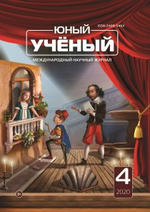Scotland is a country with beautiful wild landscapes and unique traditional dress and customs. This is the birthplace of many remarkable figures of literature and art. In addition, those whose names were included in the Golden Fund of Scotland Culture lived or stayed for a long time.
2020 is a jubilee year due to the fact that James Mathew Barrie would have turned 160 years old.
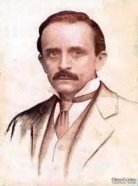
James Matthew Barrie was born on 9 th May 1860 in Kirriemuir, in the northeast of Scotland. He was the ninth child in the family. His mother, Margaret Ogilvie, focused much of her attention on one of her sons, David. He was tall, handsome, athletic, who she was sure, was destined to be a minister. But David was killed in a skating accident when barely 14. His mother never fully recovered from the blow. Her one consolation was that he remained eternally young. It is believed that David became the inspiration for Peter Pan. Although James Barrie spent a short part of his life in Kirriemuir, later renamed as “Thrums”, he set many of his stories there, based on tales told by his mother.
His university days were not very happy. James Barrie was small, only 5 feet. He was round-shouldered, pale, shy and diffident, with a round head that was too large for the rest of his body. He shrank from meeting girls; he admired them, but he was afraid of them. He had no such difficulties with children and he mixed freely with the young families of his associates. One of them, Margaret Henley, aged six, named him as “my Friendly”. But as she could not pronounce “F” properly it sounded as “Wendy”. Barrie used the name later in his most famous play.
Barrie’s love was English literature and after graduating from the University in 1882, determined to be an author, he was offered the post of a leader-writer of the Nottingham Journal. The next three years he was writing for this journal. Barrie was also sending articles to London papers. Some were set in Thrums and dealt with the activities of the Auld Lichts, an extreme Calvinist religious sect at the beginning of the 19 th century. In a humorous way the tales spoke about general intolerance, abhorrence of the harmonium and hymns and love of long services of the members of this sect.
1885 Barrie gave up his job in Nottingham and set off to freelance in London. Here he published his three books Auld Licht Idylls, A window in Thrums and The Little Minister . Robert Louis Stevenson described the latter as the work of a genius. These three books put Barrie into the front rank as an author. His writings were always full of fun and humor.
On 9 th July 1894 James Matthew Barrie married Mary Ansell, a beautiful young actress. The marriage was not a successful one. Barrie was temperamentally completely unsuited to marriage, and Mary spent 10 unhappy years with him. They had no children. Whereas Mary had to content herself with a large St. Bernard dog, Porthos; Barrie was consoling himself with other people’s children, particularly a five-year old boy named George and his brother Peter. He was completely infatuated with George, Peter and their three little brothers, John, Michael and Nico. The Barries had moved into a flat at Adelphi Terrace, overlooking Kensington Gardens, and it was there that he met and took the boys for walks every morning. Later he enacted scenes in the Park with the boys for a play. The latter was produced as Peter Pan on 27 th December 1904 in the Duke of York’s Theatre by Charles Frohman, his old friend. The play was an enormous success. Barrie forecast that the play would appear every Christmas for years and years. He was right in that and now there is even a musical version.
When the boys’ parents died, Barrie adopted the five boys rearing them as his own, sending them to Eton and Cambridge. James Barrie said to them, “I suppose that I always knew that I made Peter by rubbing the five of you violently together, as savages with two sticks produce a flame. I am sometimes asked who and what Peter is, but that is all he is, the spark I got from you”. The truth is that he is more likely Barrie himself — the man who never grew up.
In his lifetime Barrie’s worth was recognized. He received Honorary Degrees from St. Andrews University, Edinburgh University, Oxford University and Cambridge University. He was elected by the students Lord Rector of St. Andrew’s University and appointed Chancellor of Edinburgh University. He was knighted and appointed to the Order of Merit.
Towards the end of his life he took a holiday house near Kirriemuir where he was visited by the Prime Minister Ramsay MacDonald, the Duke and Duchess of York and their two daughters, Elizabeth and Margaret. Barrie allowed Margaret to contribute two lines to lines to his latest play, The Boy David , and he drew up a contract that she would receive one penny royalties for each performance. Though the play was not a great success, he was delighted and amused when he received a message in March 1937 from King George VI reminding him of the contract and informing him that if he did not pay the debt then the King’s solicitors would be in touch. Barrie, although gravely ill, gathered a bag containing the correct number of pennies which he proposed to take to Buckingham Palace in person, but he was not able to do so. He died in London on 21 st June 1937, aged 72, and was buried in the family grave at Kirriemuir.
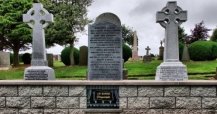
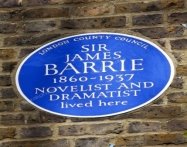
The plaque to James Barrie
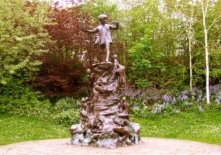
The statue of Peter Pan in Kensington Garden
References:
- Барри, Джеймс Мэтью. Питер Пэн: сказочная. повесть: для детей — Екатеринбург: Средне-Уральское книжное издательство, 1993. — 135 с.
- Барри Джеймс Мэтью Питер Пэн в Кенсингтонском саду. — Издательский дом Мещерякова. — 2016. — 216с.






